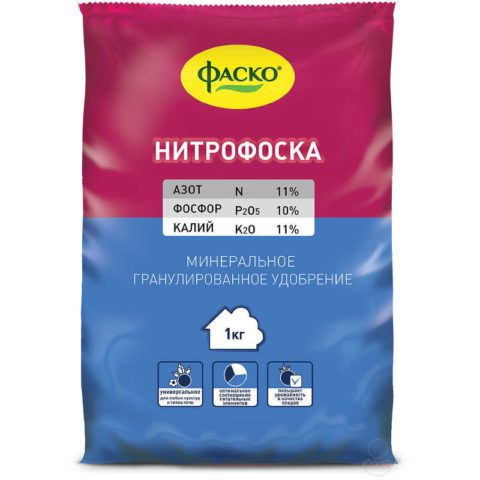Content
Chrysanthemum Anastasia is a hybrid group with the same bush size and identical planting requirements. The flower shape in all varieties is densely double, differs in the color of the petals. The plant is used in floristry and landscape design. It blooms in greenhouses all year round and is profitable for commercial cultivation.
Features of growing chrysanthemum varieties Anastasia
Depending on the climatic conditions of the region, Anastasia chrysanthemum is cultivated as an annual or perennial plant. The plant is suitable for ampelous cultivation. In cold climates, crops intended for cutting are planted in greenhouse structures. The varieties for distillation are created on the basis of the white chrysanthemum Anastasia. The plant can bloom about 6 times per season.
In the regions of the North Caucasus, the climate is suitable for growing chrysanthemums as a perennial plant. The culture blooms once at the end of summer, the cycle is long, the buds open alternately. The bush is not pruned until the temperature drops to zero. Anastasia's hybrid is relatively young, but quite popular. Its varieties are stress-resistant and have good immunity.
Chrysanthemums Anastasia are used in floristry for bouquet compositions, grown in gardens and in personal plots for the purpose of design of the territory. Subject to the light regime, this is an ideal option for decorating balconies, closed verandas and loggias.
Varieties of varieties of chrysanthemums Anastasia
Chrysanthemums Anastasia include several hybrids that differ in color. All of them are tall bush plants. The stems grow up to 1 m in height. They are crowned with single flowers with a needle-like structure of petals. All representatives of the densely doubled group belong to perennial chrysanthemums. A description of the varieties most demanded in floristry and design will allow you to choose the best option for any region.
Chrysanthemum Anastasia Dark Green
A variety of chrysanthemum Anastasia Dark Green (Chrysanthemum Anastasia Dark Green) is characterized by a rare green color. Description of the hybrid:
- the height of the peduncles is 80-95 cm;
- stems are tough, of medium thickness, resistant;
- in the upper part, several lateral shoots with single buds are formed;
- bush dense, compact, intensely leafy;
- leaf plates are dark green with light edging, wavy edges, oppositely located;
- flower diameter 13 cm, round shape, light green color;
- needle-shaped petals, concave inward, the first row is longer, the middle is closed.
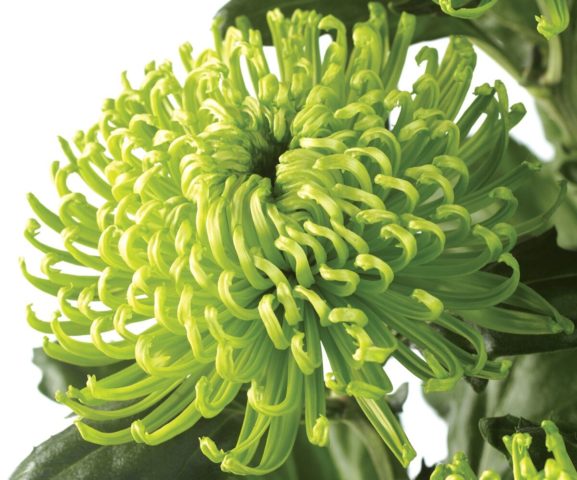
Blooms in mid-September, keeps the bouquet fresh for 21 days
Chrysanthemum Anastasia Sunny
The yellow chrysanthemum Anastasia Sunny (Chrysanthemum Anastasia Sunny) is one of the most common varieties in ornamental gardening. The variety is more resistant to temperature extremes, the cycle begins in early September and lasts until the first cold snap. External characteristic:
- dense bush, spreading, densely leafy;
- stems 70-80 cm high;
- flowers with radial petals of various lengths, do not open in the central part;
- shape - terry, diameter - 12 cm, color - light yellow.
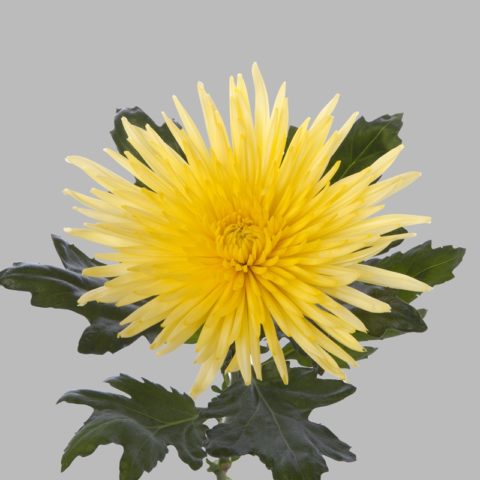
Sunny variety blooms at the end of September, the duration of the period is 25-30 days
Chrysanthemum Anastasia Lime
Anastasia Lime is a Dutch bush single-headed chrysanthemum variety. The height of the peduncles is 85-100 cm. The leaves are alternate, with wavy edges, bright green. Inflorescences are large - 16 cm in diameter, with decorative coloration. Needle white petals with lime color at the ends, the core of the chrysanthemum is light green. This is one of the new hybrids, so it is rare in gardens, mainly grown in greenhouses for cutting.
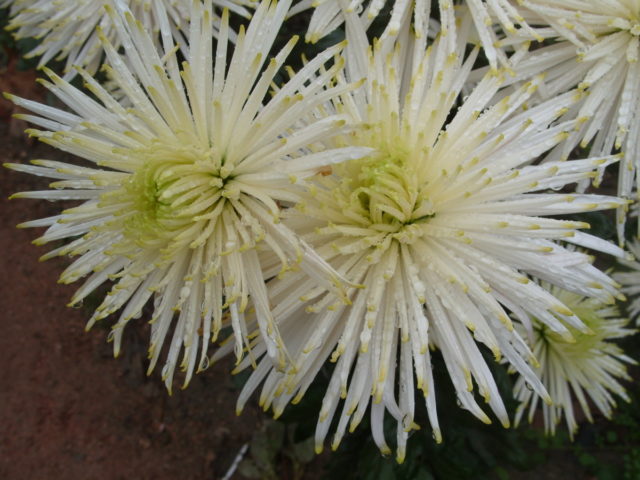
The flowering period of Anastasia Lime is mid-September
Planting one-headed chrysanthemum Anastasia
Planting dates depend on the purpose of growing. Crops are planted in greenhouses for forcing throughout the year. Chrysanthemum Anastasia blooms in 3-3.5 months. You can drop off into the container at any convenient time, here the timing does not matter. In an open area, the start of work is determined by the weather conditions, the main thing is that the soil is warmed up to 150 C, this happens around mid to late May.
Planting conditions depend on the method of growing chrysanthemum Anastasia. If hybrids are used in ornamental gardening, an open or periodically shaded area is chosen, the culture grows poorly in the shade, and forms small flowers.
Care must be taken to protect the flower bed with chrysanthemums from drafts. The culture is characterized by moderate drought resistance, but waterlogged soil is not suitable for it either. For planting, do not use places with a close location of groundwater.
Preparation of soil and planting capacity
Chrysanthemum Anastasia fully develops only on fertile soils with good aeration and drainage. The soil is chosen loamy, enriched with organic matter and nutrients, with a neutral or slightly acidic reaction. The soil composition requirements are the same for open areas as well as for greenhouses and flower containers.
In the spring, a place for planting is dug to the depth of a shovel bayonet, a mixture consisting of compost, nitrophoska and wood ash is sprinkled on top. Then the top layer is loosened to seal the substrate to a depth of 10 cm. The flower pot is chosen wide, since the root system of the culture is superficial, it grows in width by 20 cm. The soil for the container is prepared from peat, sod layer, compost and nitrophosphate.
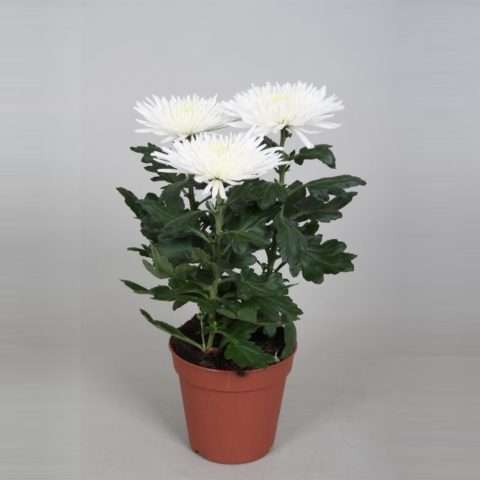
Chrysanthemum Anastasia in a flower pot does not grow more than 50-55 cm in height, the diameter of the flowers is the same as in the open field
Preparation of planting material
Anastasia chrysanthemum seedlings are purchased with a closed root (in a shipping container or with an earthen clod). Disinfection of the root system is not needed, the seedling is determined in the hole along with the soil. All green mass is preliminarily removed and the stem is shortened to 10-15 cm.
If reproduction is carried out by sowing seeds in the ground, they are preliminarily lowered for 40 minutes in a manganese solution, then in a damp cloth they are sent to the refrigerator for a day. In the case of planting by dividing an adult bush, the soil is washed off with water or shaken off, the root is placed in a growth stimulating preparation, after placement in the ground, the tops of the stems are pinched.
Landing rules
The root of the Anastasia variety is branched, forms parallel to the soil surface, deepens 15-20 cm, so it is important that the top layer is fertile and light. In greenhouses, after cutting from the site, the plant is removed along with the root and the soil is watered with hot water with the addition of manganese. For greenhouses, drainage is not laid.
Closed planting method:
- The culture is propagated mainly by seedlings. If the planting is massive, furrows are made, the depth of which is 10 cm more than the height of the root system of the seedling.
- The seedlings are placed at a distance of 30 cm, placed vertically and covered with soil, slightly compacted.
- To preserve moisture, mulch.
- Break off the tops.
When using chrysanthemum Anastasia in ornamental gardening, the planting pit is made 30 cm, the bottom is closed with drainage and a nutritious substrate, the rest of the actions do not differ from working in a greenhouse.

Planting material is determined at the place of growth together with an earthen lump.
Chrysanthemum care Anastasia
Hybrid group Anastasia - large-flowered plants with a decorative look. It will not be possible to achieve full growth and flowering without appropriate agricultural technology. Chrysanthemum is moisture-loving, but responds poorly to high air humidity and stagnant water. She needs constant feeding, pruning and observance of the light regime, especially in closed structures.
Optimal growing conditions
The light-loving chrysanthemum should be in the area so that the daylight hours are at least 13 hours. In greenhouses, special lamps are installed that work for 24 hours. To prevent high humidity, closed structures are constantly ventilated, but they do it so that there are no drafts. The culture does not tolerate a sharp change in temperature, the optimal indicator for the growing season is +220 C.
Irrigation mode for chrysanthemum Anastasia
In an open area, the frequency of watering Anastasia chrysanthemum depends on the frequency of precipitation. With a shortage of water, the culture lags behind in growth, the bush becomes sparse, the stems are thin, and the flowers are small. Waterlogged soils lead to the development of root rot and plant death.
By the number of irrigations, they are guided by the state of the upper soil layer. It should be moist to a depth of about 5 cm, this condition applies to the entire growing season. Water the plant only at the root. Sprinkling (especially during flowering) is highly undesirable.
Top dressing
The use of fertilizers is a prerequisite for growing, especially during the budding period. Top dressing is applied according to the following scheme:
- After planting seedlings or emergence of seedlings, apply nitrophosphate. The nitrogen content in the product stimulates the growth of green mass, potassium accelerates cell division.
Root top dressing can be used dry or dissolved
- During bud formation, fertilize with superphosphate, Agricola
- During the flowering period, they are fed with liquid organic matter (approximately once every 5-7 days). At the peak of the cycle, you can use potassium phosphate.
Trimming and shaping
Chrysanthemums Anastasia - bush plants, tall. Subject to the requirements of agricultural technology, they form a dense bush with a high degree of shoot formation. The main algorithm of actions to get large flowers:
- at the beginning of growth, thinner peduncles are removed;
- cut off part of the lower leaves, especially in the middle of the bush;
- at the top of the stem, several lateral shoots with buds can form, they are also removed.
Such measures are necessary so that nutrients are not distributed throughout the plant, but are aimed at the growth of central shoots and buds.
In ornamental gardening, Anastasia's chrysanthemum is not formed, it is left in its original form. After flowering, the bush is cut off completely. If regional winter temperatures drop below –180 C, then the plant is covered.
Diseases and pests
While maintaining the required temperature with low air humidity in closed structures, Anastasia chrysanthemum does not get sick. On an open area during the rainy season, when the soil is constantly wet, a fungal infection (gray mold or powdery mildew) can develop. Topaz will help get rid of the problem.

In order to prevent, the plant and the soil around it are treated in spring.
At the first signs of the disease, the bush is sprayed with a working solution.
At high air humidity, aphids parasitize the chrysanthemum, and Spark gets rid of it.
Reproduction of chrysanthemum Anastasia
The culture provides a complete planting material that retains all the characteristics of the parent plant. Seeds are harvested in the fall, in February they are sown to obtain seedlings, in the spring they are transferred to the site. Part of the bushes is specially left in greenhouses to obtain material that is harvested at the end of the season.
Chrysanthemum can be propagated by cuttings. To do this, until the moment of budding, fragments are cut from strong shoots. They are determined in containers with nutrient soil, after rooting, they are brought into the room until spring, stored at a temperature of + 10-150 C. Chrysanthemum is not left in one place for more than 3 years. In the fourth year in spring, propagate by dividing the bush.
Conclusion
Chrysanthemum Anastasia is presented in several varieties with different colors. Large-flowered culture, densely double, created for forcing in greenhouses. In the Middle, Central zone and areas with a more severe climate, hybrid groups are grown only in a closed way. In the South, it is used in ornamental gardening and cultivated as a perennial plant.
